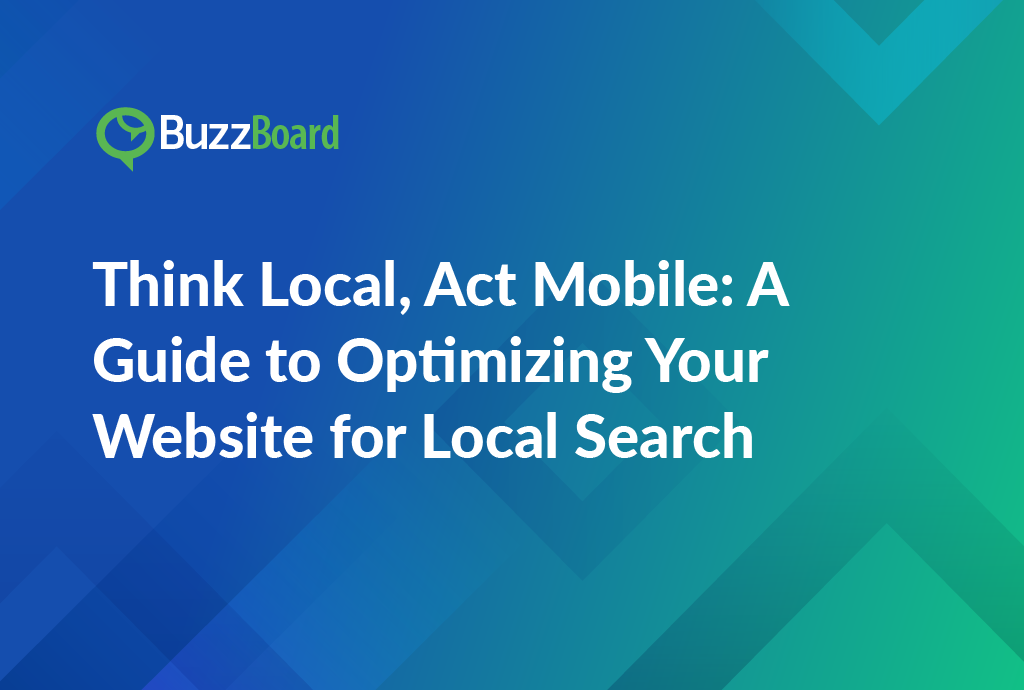Summary
What is the key to getting client’s website noticed? Optimizing their website for local search is crucial. In this guide, we’ll walk you through the essential steps to improve local search rankings and drive more foot traffic. From claiming and verifying your Google My Business listing to optimizing your website’s structure and content for local keywords, we’ll cover it all. Learn how to think local and act mobile to boost your online visibility and attract more customers for your client.
Understanding the Importance of Optimizing Your Local Business Website
Optimizing a local business website is much more than simply refining its design; it extends to an in-depth analysis of the site’s structural foundation. The goal is to amplify not only the website’s performance but also its accessibility, and the overall user experience it offers, especially on mobile platforms.
As the digital field steadily progresses, mobile website optimization has become the standard, surpassing its prior status as a trend. Current data show that 63% of Google’s U.S. organic search traffic comes from mobile devices. This statistic underscores the need for a local business website to be mobile responsive to accommodate an expanding demographic.
Optimization is a crucial aspect of successful local business marketing, and it doesn’t stop at creating a website. To truly maximize online visibility and drive business growth, local businesses must employ intelligent optimization strategies to enhance their SEO ranking. This involves incorporating targeted keywords and local search terms into their content, which significantly increases their likelihood of appearing in local search results. By doing so, they can attract the attention of potential customers in their immediate area, ultimately driving foot traffic and sales to their physical location.
A well-optimized local business website is more than just an informational entity – it’s a potent marketing tool that can catalyze increased traffic, generate more leads, and facilitate prospective conversions. When done correctly, website optimization can be a game-changer for local businesses, enabling them to reach a wider audience, increase brand awareness, and ultimately drive business growth.
For digital marketing professionals serving small and local businesses, understanding and championing website optimization is crucial. By educating clients on the importance of website optimization, you can help them view their website as an invaluable online marketing asset. This can reshape their marketing strategy, enabling them to focus on the most effective channels and tactics to drive business results.
Some key optimization strategies to focus on include:
- Conducting thorough keyword research to identify relevant and high-traffic search terms
- Incorporating local search terms and phrases into website content, meta tags, and alt tags
- Optimizing website structure and architecture to improve crawlability and indexability
- Creating high-quality, engaging, and informative content that resonates with local audiences
- Building high-quality backlinks from authoritative sources to increase website authority and credibility
- Ensuring website mobile-friendliness and responsiveness to cater to the majority of users who access the internet through mobile devices
- Regularly monitoring and analyzing website performance using tools such as Google Analytics to identify areas for improvement
By implementing these strategies and continuously monitoring and optimizing their website, local businesses can improve their online visibility, drive more traffic and conversions, and ultimately achieve their business goals. As a digital marketing professional, it’s your job to educate and empower your clients to take control of their online presence and reap the benefits of a well-optimized website.
The Role of Mobile Website Design in Local Business Marketing
Optimizing a local business website is no longer a nice-to-have, but a must-have for success. With the majority of consumers using mobile devices to search for products and services online, having a mobile-friendly website is no longer a luxury, but a necessity. A responsive, mobile-friendly website is essential for reaching a larger audience, improving customer engagement, and driving conversions.
The importance of mobile website design in local business marketing cannot be overstated. A well-designed mobile website not only adheres to SEO best practices, but also provides a seamless user experience that is essential for building trust and loyalty with customers. A mobile-friendly website makes it easy for customers to access information about your local business, products, or services, which can significantly impact customer conversion rates and return-on-investment (ROI).
When it comes to optimization, a mobile-friendly website design offers numerous advantages for local businesses. It helps to:
- Improve search engine rankings: A mobile-friendly website is more likely to rank higher in search engine results pages (SERPs), making it easier for customers to find your business.
- Boost website traffic: A responsive website design can increase website traffic by making it easy for customers to navigate and find what they’re looking for.
- Enhance user engagement: A mobile-friendly website provides a better user experience, which can lead to increased engagement, longer session times, and higher conversion rates.
- Improve customer satisfaction: A well-designed mobile website can improve customer satisfaction by providing easy access to information, making it easier for customers to find what they need, and reducing frustration.
All these factors contribute to better local business marketing results, including increased sales, improved brand awareness, and enhanced customer loyalty. Therefore, salespeople at digital marketing agencies should highlight the importance of mobile website design to their small and local business clients. Its impact stretches beyond mere responsiveness – it could significantly boost a business’s online presence and revenue opportunities.
In addition, a mobile-friendly website design can also help local businesses to:
- Stay ahead of the competition: By having a mobile-friendly website, local businesses can stay ahead of the competition and establish themselves as leaders in their industry.
- Increase online visibility: A mobile-friendly website can increase online visibility, making it easier for customers to find your business and increasing the chances of attracting new customers.
- Improve customer retention: A well-designed mobile website can improve customer retention by providing a seamless user experience, making it easier for customers to find what they need, and reducing frustration.
To gain more insight on enhancing your local business website for mobile, follow the link. Take the proactive step today to improve your local business marketing strategy and reap the benefits of a well-optimized mobile website.
Remember, a well-optimized mobile website is no longer a required base, but a linchpin for local business success in today’s digital era. It’s essential for building trust, improving customer engagement, and driving conversions. By prioritizing mobile website design, local businesses can stay ahead of the competition, increase online visibility, and improve customer retention.
Practical Steps for Improving and Optimizing Your Mobile Website for Local Search
Optimizing your local business website for a seamless mobile experience is no longer a luxury, but a necessity in today’s mobile-dominated era. A well-optimized mobile website can significantly enhance your local business marketing efforts, driving more traffic, increasing conversions, and ultimately, boosting your bottom line. In this section, we’ll provide a comprehensive guide on how to improve and optimize your mobile website for local searches, ensuring that your business stays ahead of the competition.
Responsive Website Design: The Foundation of Mobile Optimization
A responsive website design is the first step towards creating a mobile-friendly website. This type of layout adapts to the viewer’s device, providing an optimal viewing experience regardless of screen size. A responsive design ensures that your website looks great on desktops, laptops, tablets, and smartphones, without compromising on functionality or user experience. This strategy is not only crucial for user experience but also for search engine optimization (SEO). Google puts significant weight on mobile optimization in their algorithm, and a responsive design is a key factor in determining your website’s mobile-friendliness.
Load Speed: The Key to Keeping Mobile Users Engaged
In today’s fast-paced digital landscape, users expect websites to load quickly. In fact, studies have shown that users often abandon websites that take more than three seconds to load. This means that load speed is crucial for keeping mobile users engaged and converting. To optimize your website’s load speed, consider the following strategies:
- Compress images and files to reduce file size
- Use a content delivery network (CDN) to distribute content across different servers
- Minify and compress HTML, CSS, and JavaScript files
- Optimize server response time and reduce latency
Optimizing Content for Local Search
To improve visibility in local searches and drive local traffic to your website, it’s essential to optimize your content for local search. Here are some strategies to consider:
- Include your city, region, or neighborhood in your page titles, meta descriptions, and throughout your content
- Use location-specific keywords in your content, such as “best restaurants in [city]” or “top [industry] in [region]”
- Create location-specific content, such as blog posts or videos, that cater to local audiences
- Use schema markup to provide additional context to search engines about your business’s location and services
Make Your Contact Details Easily Accessible
Make it easy for customers to find and contact your business by keeping your contact details easily accessible. Here are some strategies to consider:
- Display your name, address, and phone number prominently on your website
- Use a consistent contact format across all platforms, including social media and online directories
- Use schema markup to provide additional context to search engines about your business’s contact information
- Consider adding a contact form or email address to your website for customers to get in touch with you
Schema Markup: Enhancing Search Engine Results
Schema markup is a semantic vocabulary that provides additional context to search engines about your business’s content, products, and services. When implemented correctly, schema markup can result in rich site snippets, enhancing click-through rates and website rankings. Here are some strategies to consider:
- Use schema markup to provide additional context to search engines about your business’s products and services
- Use schema markup to highlight your business’s reviews and ratings
- Use schema markup to provide additional context to search engines about your business’s location and hours of operation
- Consider using schema markup to highlight your business’s events, promotions, and offers
Encouraging Online Reviews
Online reviews play a crucial role in influencing purchasing decisions. In fact, studies have shown that the majority of consumers check online reviews before making a purchase. Here are some strategies to encourage online reviews:
- Encourage customers to leave a review on platforms like Google My Business after a successful transaction
- Respond promptly to online reviews, both positive and negative, to show customers that you value their feedback
- Consider offering incentives, such as discounts or free services, to customers who leave online reviews
- Use schema markup to highlight your business’s reviews and ratings, making it easier for customers to find and read them
By implementing these strategies, you can optimize your local business website for a seamless mobile experience, driving more traffic, increasing conversions, and ultimately, boosting your bottom line. Remember, a well-optimized mobile website is no longer a luxury, but a necessity in today’s mobile-dominated era.
Real-World Examples of Successful Local Business Website Optimizations
Optimizing a local business website can secure considerable gains for small-scale enterprises. Leveraging proven strategies like website design enhancement and mobile optimization can markedly increase a business’s online visibility.
Consider Bob’s Brick Oven, a rural Georgian pizzeria. Before optimization, their website languished unrecognized in the vast digital sea. But through diligent local business marketing and a website redesign, they amplified their online presence. Now, their website, complete with mobile compatibility, effectively captures their rustic charm for both their local audience and potential customers beyond.
Paul’s Pet Store in Portland offers another example of local success. An overhaul of the website’s design to make it more user-friendly resulted in a significant uptick in online sales and local foot traffic. Here, an optimized mobile website proved crucial, as customers could conveniently browse and purchase products on the go.
These real-world examples underscore the potential of optimizing a local business website. They spotlight the effectiveness of this tool in broadening business outreach when used correctly. Therefore, it’s an invaluable strategy for local and small businesses.
If you’re aiming to optimize your own local business site or seeking tips to guide your clients, visit our detailed guide titled “”Improving Local Business Online Presence”” and embark on your optimization journey today.
The Challenges and Benefits of Optimizing Your Local Business Website for Mobile
Optimizing a local business website for mobile devices presents a unique set of challenges and opportunities that require careful consideration and attention to detail. At the heart of this process is the need to ensure that the website is accessible, functional, and visually appealing on all devices, including smartphones, tablets, and desktop computers. This requires a meticulous approach to template selection, layout, and navigation, as well as a deep understanding of the user experience and how it can be optimized for mobile devices.
One of the primary obstacles to mobile optimization is the need to adapt a website’s design and layout to accommodate the smaller screens and touch-based interfaces of mobile devices. This can be a complex and time-consuming process, requiring significant investments of time and resources. However, the benefits of a correctly optimized mobile website far outweigh the challenges, and can have a significant impact on a local business’s online presence and customer engagement.
For example, optimizing a local business website for mobile devices can help to increase its visibility and reach a wider audience, as mobile searches now exceed desktop searches. This is particularly important for local businesses, which rely heavily on online search traffic to attract new customers and drive sales. By optimizing their website for mobile devices, local businesses can ensure that they are visible and accessible to customers who are searching for their products or services on-the-go.
In addition to increasing visibility and reach, optimizing a local business website for mobile devices can also enhance the user experience and lead to higher customer engagement. This is because mobile devices offer a more intimate and personalized way of interacting with a website, allowing customers to quickly and easily find the information they need and take action. By optimizing their website for mobile devices, local businesses can create a more seamless and intuitive user experience that drives customer engagement and loyalty.
Furthermore, optimizing a local business website for mobile devices is a crucial component of local business marketing strategies. By incorporating location-based services and local-specific keywords, local businesses can increase their visibility and reach among local customers, driving more foot traffic and sales to their physical locations. This is particularly important for local businesses that rely heavily on local customers and need to be visible and accessible to them in order to thrive.
As salespeople in digital marketing agencies, understanding the complexities and benefits of mobile optimization for local business websites is essential for making educated decisions for our clients. By optimizing their website for mobile devices, we can help local businesses to drive more traffic, increase customer engagement, and ultimately grow their business. This is particularly important in today’s increasingly mobile-focused market, where more and more customers are using their mobile devices to search for products and services and interact with businesses online.
Optimizing a local business website for mobile devices is a critical component of any local business marketing strategy. By understanding the challenges and benefits of mobile optimization, local businesses can create a more visible, accessible, and engaging online presence that drives customer engagement and loyalty. As salespeople in digital marketing agencies, we have a unique opportunity to help local businesses to thrive in today’s mobile-focused market by optimizing their website for mobile devices and creating a more seamless and intuitive user experience.
Conclusion
Optimizing your website for local search is crucial in today’s digital landscape. By “thinking local and acting mobile”, businesses can increase their online visibility, drive more foot traffic, and ultimately boost their bottom line. The article has provided a comprehensive guide on how to optimize your website for local search, from claiming and verifying your Google My Business listing to creating high-quality, location-specific content. Additionally, it has emphasized the importance of mobile-friendliness, fast page loading speeds, and accurate citations to ensure that your website is search engine friendly. By implementing these strategies, businesses can improve their local search rankings, increase their online presence, and ultimately attract more customers.









